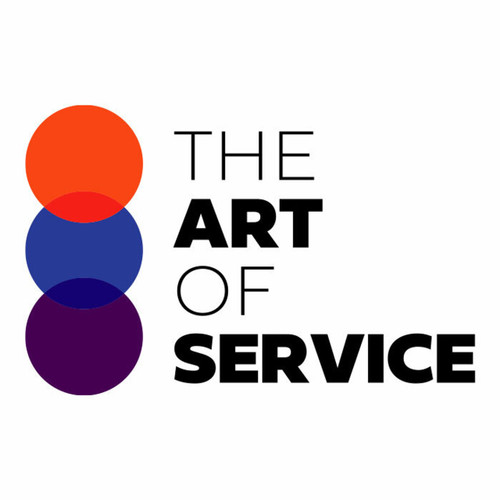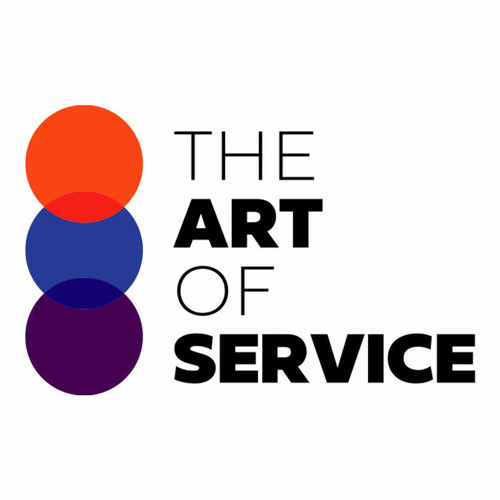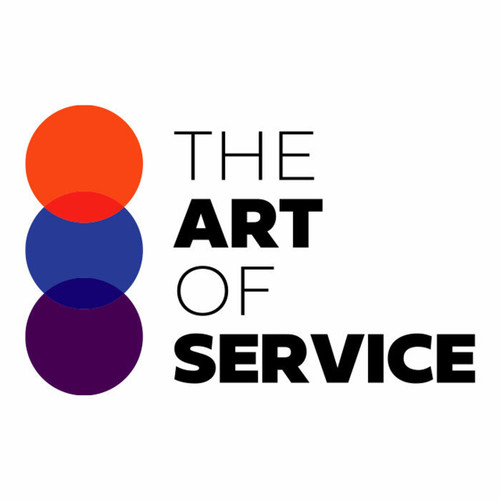Our Value Driven Delivery and Agile Methodologies Knowledge Base is here to save the day.
This comprehensive dataset contains 1568 prioritized requirements, solutions, benefits, results, and even real-life case studies/use cases.
With this knowledge base, you′ll have all the important questions to ask in order to get results based on urgency and scope.
But what sets us apart from our competitors and alternatives? Our Value Driven Delivery and Agile Methodologies dataset is designed specifically for professionals like you who are looking for a DIY and affordable alternative.
Unlike other products, our dataset is easy to use and provides a detailed overview of specifications and product types.
Our dataset is not just a product, but a valuable tool for businesses looking to optimize their delivery and project management processes.
By leveraging the power of Value Driven Delivery and Agile Methodologies, your business can save time, increase efficiency, and improve overall results.
But don′t just take our word for it.
Our product has been extensively researched and proven to be effective in various industries.
Plus, with its cost-effective price point, it′s a no-brainer investment for any company looking to stay ahead in today′s fast-paced business world.
We understand that every business and individual has different needs, which is why we offer a variety of options for our dataset.
Whether you′re a small business or a large corporation, our product caters to all your needs.
So why wait? Take advantage of our Value Driven Delivery and Agile Methodologies Knowledge Base and see the difference it can make for your business.
Say goodbye to trial and error and hello to streamlined processes and impressive results.
Get your copy today and experience the benefits for yourself!
Discover Insights, Make Informed Decisions, and Stay Ahead of the Curve:
Key Features:
Comprehensive set of 1568 prioritized Value Driven Delivery requirements. - Extensive coverage of 182 Value Driven Delivery topic scopes.
- In-depth analysis of 182 Value Driven Delivery step-by-step solutions, benefits, BHAGs.
- Detailed examination of 182 Value Driven Delivery case studies and use cases.
- Digital download upon purchase.
- Enjoy lifetime document updates included with your purchase.
- Benefit from a fully editable and customizable Excel format.
- Trusted and utilized by over 10,000 organizations.
- Covering: Product Owner, Agile Sprint, Velocity Measurement, Scaling Agile, Self Organizing Teams, Cross-Functional Teams, Team Empowerment, Agile Ceremonies, Agile Collaboration, Agile Budgeting, Predictive Method, Process Change Tracking, Agile Outsourcing, Scalable Processes, Kanban Boards, Agile Feature, Value Driven Delivery, ERP Project Team, Continuous Delivery, Agile Project, Agile Release Planning, Software Applications, Empirical Process Control, Control System Engineering, Facilitation Skills, Product Vision, Agile Artefacts, Agile Scrum Master, Daily Stand Up, Incremental Prototyping, Team Cohesion, Product Increments, Agile Estimation, Iterative Development, Technical Debt, Operational Revolution, Agile Roles, Pair Negotiation, Agile Documentation, Agile Analysis, Continuous Testing, Collective Ownership, Empowered Teams, Release Planning, Sprint Burndown Chart, Communication Channels, User Requirements, Refactoring Code, Sprint Review, Daily Scrum, Delivery Methodology, User Acceptance Testing, Sprint Planning, Iterative Product Development, Definition Of Done, Test-Driven Development, Agile Project Management, Product Increment, Scrum Master, Scaling Agility, Estimation Techniques, Agile Stakeholder Management, Cross-Functional Collaboration, Agile Reporting, Agile Team, Collaborative Environment, Agile Methodology, Agile Metrics, Time Management, User Stories, Work Method Change, Adaptive Planning, User Expertise, Real Time Feedback, Continuous Integration, Agile Planning, Scrum Board, Agile Product Management, Agile Coaching, Product Backlog, Virtual Work Environment, Agile Risk Management, Agile Modeling, Working Software, Scrum Principles, Information Technology, Enterprise Architecture Methodologies, Agile Facilitator, Agile Implementation, Agile Testing, Rapid Prototyping, Agile Tooling, Burn Down Chart, Business Value, Sprint Backlog, Emergent Design, Adaptive Workflows, Production Deployment, User Centered Design, IT Systems, Agile Values, Cross Functional Teams, Optimization Methods, Agile Transformation, ERP Consulting, Continuous Professional Development, Multinational Corporations, ERP WORK Project, User-Centered Design, Test methodologies, Agile Decision Making, Agile Principles, Agile Monitoring, Iterative Process, Agile User Experience, Supply Chain Complexity, Facilitated Workshops, Agile Retrospective, Product Roadmap, Product Definition, Kanban Practices, Agile Lean, Agile Work, Real-Time Communication, User Validation, Velocity Tracking, Frequent Delivery, Agile Communication, Hybrid Methods, ERP Tracking Software, Agile Facilitation, Agile Adaptation, Agile Customer Service, Real-Time Feedback, Software Testing, Agile Workshops, Agile Training, Team Collaboration Method, Agile Project Delivery, Acceptance Criteria, Agile Quality, Kanban Board, Incremental Development, Agile Frameworks, Test Driven Development, Agile Scrum, Lean Principles, Technical Excellence, Agile Manifesto, Stakeholder Engagement, Minimum Viable Product, Retrospective Techniques, Prioritization Techniques, Agile User Stories, DevOps, Backlog Refinement, Risk Management, Collaborative Decision Making, Scrum values, Sprint Reviews, Agile Mindset, Agile Methodologies, Lean HR, Agile Simulation, EA Methodologies, Short Feedback Loops, Scrum Meetings, User Story Mapping, Scope Management, ERP Software Implementation, Quality Assurance, Progressive Elaboration, Customer Collaboration, Agile Leadership, Project management maturity, Waterfall Methodology, Agile Sprint Planning, Process Improvement Methodologies, Agile Artifacts, Task Boards, Pair Programming, Sprint Goals
Value Driven Delivery Assessment Dataset - Utilization, Solutions, Advantages, BHAG (Big Hairy Audacious Goal):
Value Driven Delivery
An audit or risk management leader can help the organization by utilizing data-driven GRC to align business goals and risks, identify opportunities for improvement, and ensure value-driven delivery of services.
1. Encourage continuous collaboration between business stakeholders and agile teams.
- Benefits: Ensures alignment of value-driven goals and promotes shared ownership and decision-making.
2. Implement feedback loops, such as sprint reviews and retrospectives, to gather insights for improvements.
- Benefits: Allows for quick adaptation and enhances the delivery of value-driven solutions.
3. Prioritize deliverables based on customer value and business objectives.
- Benefits: Maximizes the impact of each deliverable, resulting in improved ROI and customer satisfaction.
4. Incorporate risk management processes into the Agile framework.
- Benefits: Mitigates potential risks and ensures compliance while still maintaining agility and flexibility.
5. Utilize data-driven analytics and metrics to track progress and inform decision-making.
- Benefits: Provides visibility into performance, allows for data-based optimizations, and supports evidence-based decision-making.
6. Emphasize a culture of experimentation, learning, and adaptation.
- Benefits: Fosters innovation, encourages continuous improvement, and leads to a more resilient and responsive organization.
7. Empower and trust teams to make decisions and take ownership of their work.
- Benefits: Cultivates a sense of ownership and accountability, leading to higher motivation and productivity.
8. Involve audit and risk management leaders from the beginning of project planning and throughout the project lifecycle.
- Benefits: Allows for early identification of potential risks and compliance considerations, resulting in a more efficient and effective delivery process.
9. Promote transparent communication and knowledge sharing across teams and departments.
- Benefits: Enhances alignment, promotes collaboration, and reduces silos, resulting in higher quality deliverables.
10. Continuously reassess and adjust the agile approach to fit the changing needs and priorities of the organization.
- Benefits: Enables flexibility and adapts to evolving market demands, ensuring the delivery of valuable solutions.
CONTROL QUESTION: What can an audit or risk management leader do to help the organization move towards transformational value delivery through data driven GRC?
Big Hairy Audacious Goal (BHAG) for 10 years from now:
In 10 years, Value Driven Delivery and data driven GRC will revolutionize the way organizations operate. As an audit or risk management leader, my goal is to lead the charge and help my organization fully embrace this transformative approach.
By 2031, my vision is to have successfully integrated data analytics and risk management into every aspect of our operations. We will be using real-time, AI-powered data to drive decision-making and anticipate potential risks and opportunities. Our audit processes will focus not just on compliance, but also on adding value through insights gained from data analysis.
To achieve this goal, I will work to build a culture of data-driven decision making throughout the organization. This means investing in training and resources for staff at all levels, and incentivizing them to use data to drive results.
I will also push for collaboration and integration across departments, breaking down silos and promoting a unified approach to data management. This will ensure that the data we collect is shared and utilized effectively throughout the organization.
In addition, I will advocate for the adoption of best-in-class data analytics tools and technologies. This could include investing in predictive analytics, machine learning, and other emerging technologies that can help us uncover new insights and drive continuous improvement.
Through these efforts, I am confident that by 2031, our organization will have transformed into a data-driven powerhouse, delivering exceptional value to our stakeholders and leading the way in value-driven delivery and data-driven GRC.
Customer Testimonials:
"This dataset is more than just data; it`s a partner in my success. It`s a constant source of inspiration and guidance."
"I`ve recommended this dataset to all my colleagues. The prioritized recommendations are top-notch, and the attention to detail is commendable. It has become a trusted resource in our decision-making process."
"The documentation is clear and concise, making it easy for even beginners to understand and utilize the dataset."
Value Driven Delivery Case Study/Use Case example - How to use:
Case Study: Transformational Value Delivery through Data Driven GRC at XYZ Corporation
Synopsis of Client Situation:
XYZ Corporation is a multinational organization that operates in various industries including healthcare, manufacturing, and technology. The company has a complex organizational structure, with multiple business units and subsidiaries across different countries. As the company continues to grow, it faces various challenges in managing risks and complying with regulatory requirements. The traditional approach to governance, risk, and compliance (GRC) has become inefficient, time-consuming, and costly for the organization. In addition, the lack of visibility into risks and compliance data has led to reactive decision-making, which has hindered the company′s ability to achieve its business objectives.
The company′s audit and risk management leader recognizes the need for transformational value delivery through data-driven GRC. They believe that by leveraging data analytics, innovative technologies, and a value-driven delivery approach, the organization can enhance its risk management capabilities and create significant business value.
Consulting Methodology:
To help XYZ Corporation move towards transformational value delivery, our consulting firm recommends a three-phase approach: assess, design, and implement.
1. Assess:
The first phase involves conducting a comprehensive assessment of the company′s current GRC processes, systems, and data. This includes reviewing existing policies, procedures, and controls, as well as identifying the underlying technologies and data sources. We will also conduct interviews with key stakeholders to understand their pain points and expectations.
This phase will help identify the gaps and weaknesses in the current GRC approach, and provide a baseline for future improvements.
2. Design:
The design phase involves developing a data-driven GRC strategy for the organization. This includes defining the desired outcomes, identifying the key metrics and performance indicators, and creating a roadmap for implementation. Our team will work closely with the audit and risk management leader to align the GRC strategy with the company′s overall business goals and objectives.
In addition, we will design a GRC framework that integrates data analytics, automated processes, and risk-based decision-making. This will ensure that the organization has real-time visibility into its risks and compliance status, allowing for proactive decision-making.
3. Implement:
The last phase entails implementing the data-driven GRC strategy. This involves selecting and implementing suitable technology solutions, building data analytics capabilities, and automating processes where possible. Our team will also provide training and change management support to ensure smooth adoption of the new GRC approach.
Deliverables:
1. GRC Assessment Report: A comprehensive report that outlines the current state of GRC at XYZ Corporation, identifies areas for improvement, and provides recommendations for enhancing the GRC approach.
2. Data-Driven GRC Strategy: A detailed plan that defines the desired outcomes, performance metrics, and implementation roadmap for data-driven GRC.
3. GRC Framework: A framework that integrates data analytics, automated processes, and risk-based decision-making to enhance GRC capabilities.
4. Technology Solutions: Selection and implementation of suitable technology solutions to support data-driven GRC, such as GRC software, data analytics tools, and automation platforms.
Implementation Challenges:
Implementing a data-driven GRC approach may face several challenges, including resistance to change, limited resources and budget, and data governance issues. To mitigate these challenges, our consulting team will work closely with the audit and risk management leader to ensure buy-in from key stakeholders, manage resources effectively, and establish proper data governance processes.
KPIs:
The success of this project will be measured by the following KPIs:
1. Reduction in time and effort spent on compliance activities.
2. Increase in the efficiency and effectiveness of risk management processes.
3. Improvement in the ability to identify and mitigate risks in a timely manner.
4. Reduction in the number of compliance breaches and associated costs.
5. Increase in the overall maturity level of GRC processes.
6. Positive feedback from key stakeholders about the new GRC approach.
Management Considerations:
To ensure the sustainability of the data-driven GRC approach, the audit and risk management leader needs to consider the following:
1. Data Governance: Establishing strong data governance processes will be essential for maintaining the integrity and accuracy of data used in GRC decision-making.
2. Continuous Improvement: The GRC framework and processes should be regularly reviewed and improved to keep up with changing business and regulatory requirements.
3. Talent Development: Training and development programs should be provided to employees involved in GRC activities to enhance their skills in data analytics, automation, and risk management.
4. Executive Support: Senior leadership should provide continuous support and investment in the data-driven GRC initiative to ensure its success.
Conclusion:
In summary, by adopting a data-driven GRC approach, XYZ Corporation can overcome the challenges in traditional GRC and achieve transformational value delivery. Our consulting firm′s methodology focuses on assessing the current state, designing a data-driven GRC strategy, and implementing the necessary changes to improve GRC capabilities. With proper management considerations and effective measurement of KPIs, the organization can achieve significant improvements in efficiency, risk management, and overall business value.
Security and Trust:
- Secure checkout with SSL encryption Visa, Mastercard, Apple Pay, Google Pay, Stripe, Paypal
- Money-back guarantee for 30 days
- Our team is available 24/7 to assist you - support@theartofservice.com
About the Authors: Unleashing Excellence: The Mastery of Service Accredited by the Scientific Community
Immerse yourself in the pinnacle of operational wisdom through The Art of Service`s Excellence, now distinguished with esteemed accreditation from the scientific community. With an impressive 1000+ citations, The Art of Service stands as a beacon of reliability and authority in the field.Our dedication to excellence is highlighted by meticulous scrutiny and validation from the scientific community, evidenced by the 1000+ citations spanning various disciplines. Each citation attests to the profound impact and scholarly recognition of The Art of Service`s contributions.
Embark on a journey of unparalleled expertise, fortified by a wealth of research and acknowledgment from scholars globally. Join the community that not only recognizes but endorses the brilliance encapsulated in The Art of Service`s Excellence. Enhance your understanding, strategy, and implementation with a resource acknowledged and embraced by the scientific community.
Embrace excellence. Embrace The Art of Service.
Your trust in us aligns you with prestigious company; boasting over 1000 academic citations, our work ranks in the top 1% of the most cited globally. Explore our scholarly contributions at: https://scholar.google.com/scholar?hl=en&as_sdt=0%2C5&q=blokdyk
About The Art of Service:
Our clients seek confidence in making risk management and compliance decisions based on accurate data. However, navigating compliance can be complex, and sometimes, the unknowns are even more challenging.
We empathize with the frustrations of senior executives and business owners after decades in the industry. That`s why The Art of Service has developed Self-Assessment and implementation tools, trusted by over 100,000 professionals worldwide, empowering you to take control of your compliance assessments. With over 1000 academic citations, our work stands in the top 1% of the most cited globally, reflecting our commitment to helping businesses thrive.
Founders:
Gerard Blokdyk
LinkedIn: https://www.linkedin.com/in/gerardblokdijk/
Ivanka Menken
LinkedIn: https://www.linkedin.com/in/ivankamenken/







